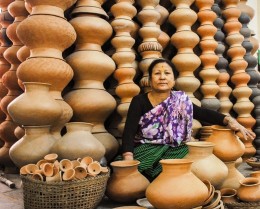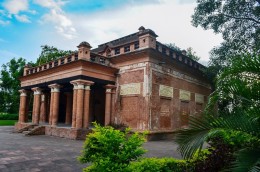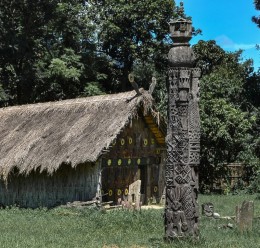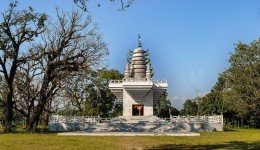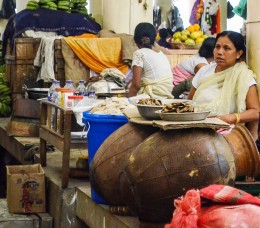
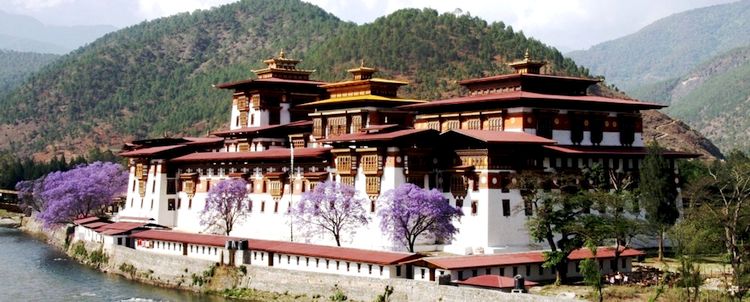
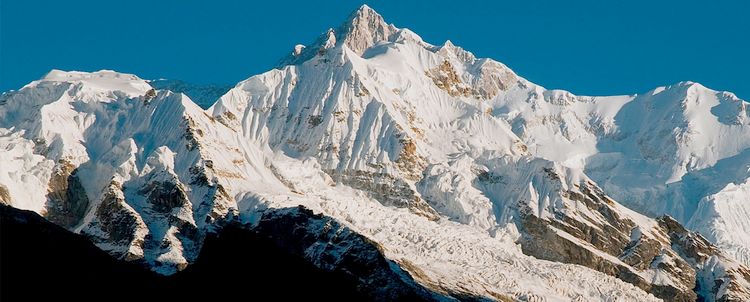
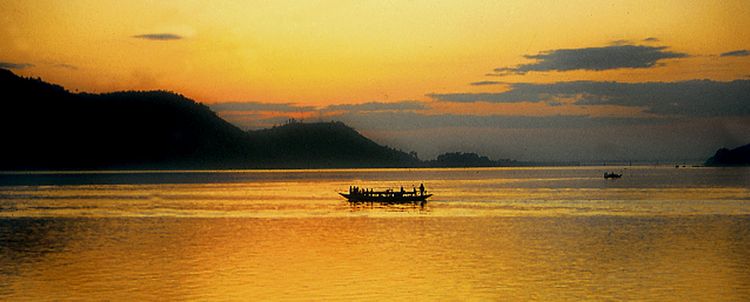
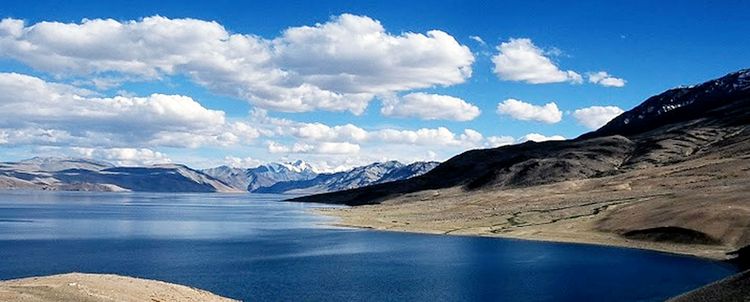
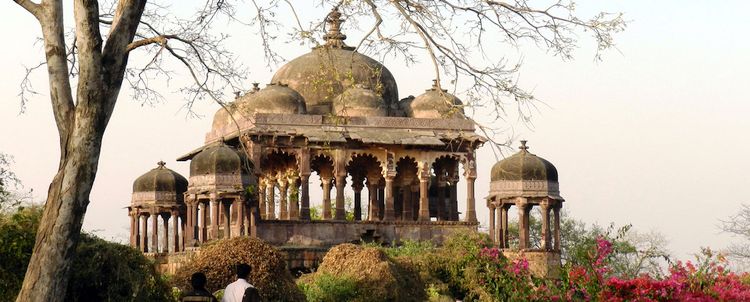
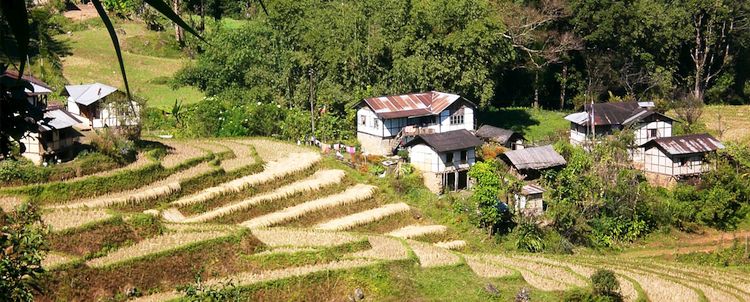
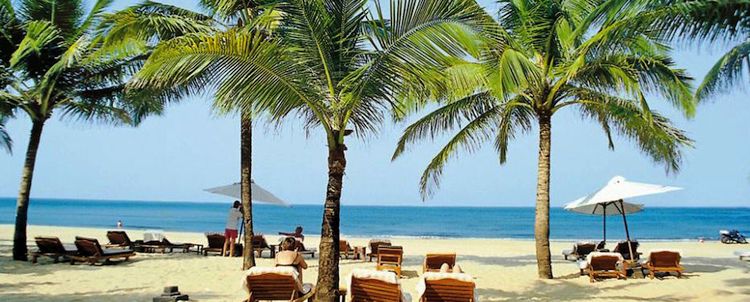
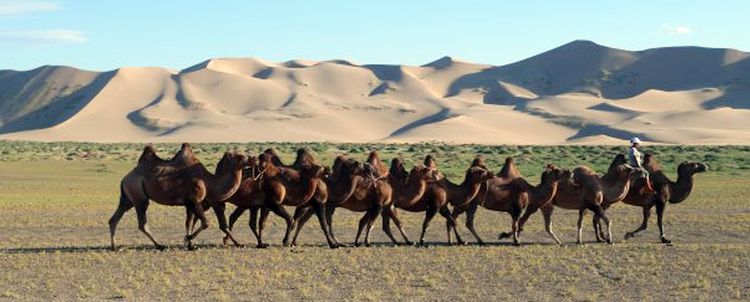
Manipur - The North East Indian Jewel Between Burma & Nagaland
Best Travel Period | Manipur in Brief | Peoples and Religions | Food | Flora and Fauna | Mountain Scenery and Trekking | National Parks and Nature Reserves | History | Economy | Festival Calendar
The former principality of Manipur, with its 22,327 km² area, is one of the "Seven Sisters", the federal states forming the remote north-east of the Republic of India. The eastern border separates India from Myanmar, to the south lies the province of Mizoram, in the west the tea country of Assam as well as Nagaland with its numerous tribes in the north. On aerial photographs can be wonderfully seen why Manipur received its nickname "the jewel": protected by a ring of emerald green forested mountains, the 2000 square kilometers large, almost perfectly oval shaped Imphal Valley is located at the center, where Lake Loktok with its 40 km² adds blue-green shimmering splashes of color.
And also in detail one can understand the justification for this nickname: Manipur enchants with a profusion of flowers. Not only in the valley, but also in the surrounding mountains prevails a climate that encouraged the development of diverse plant and animal species.
Two-thirds of the country's surface area is still almost unchanged by human hand today, so that this treasure trove has been preserved and not only enchants foreign visitors. Many species of orchids and medicinal plants are being cultivated in Manipur from the government side, in order to preserve them. The population which is quite small for Indian conditions made this possible - 122 people live statistically on a square kilometer, but almost 70% of the total population is settled in the Imphal valley and only a few in the surrounding mountains.
The various landscape types of today's federal state also offered space for very different cultures to develop. Almost exclusively in the valley live the Manipuri, a large tribe of people who has been part of the colorful Hindu religion for centuries, and who pays tribute to the gods in elaborately designed temples and shrines, as well as by carefully prepared choreographies of ritual dances. The mountains are populated by various, smaller tribes, which can be attributed to the Naga peoples as well as tribes from neighboring Myanmar. Although these indigenous peoples were christianized in the 19th century, shamanistic rites and the natural way of life survived.
Not only the amazing biodiversity, but also the cultural diversity of Manipur invites you to build the bridge to India in the direction of Imphal and immerse yourself in the colorful activities on the busy markets, the fascinating water landscape of Lake Loktok and the ancient way of life of the mountain peoples.
Best Travel Period
From October to April, the climate of Manipur invites you to explore the nature of the country and the culture of its people. After the monsoon, which dominates the weather from May to the end of September, has poured down its water masses and covered the country with lush green, the exciting harvesting season begins. During the winter months, the climate is pleasantly mild, and the spring, when the countryside is covered with fresh greenery and colorful flowers, is a particularly charming travel season.
Manipur in Brief
| Location | In the remote mountains of Northeast India as part of the "Seven Sisters", between Myanmar (Burma) in the east and three further north-east Indian states: Nagaland in the north, Assam in the west, Mizoram in the south. |
| Area | 22.327 km² |
| Population | 2.721.756/ 122 per km² (2011) |
| Capital | Imphal |
| Districts | 9: Bishnupur, Chandel, Churachandpur, Imphal East, Imphal West, Senapati, Tamenglong, Thoubal, Ukhrul |
| Topography | Manipur is located in the southeastern foothills of the Himalayas (Patkai Mountains), the highest peak is the Khayang Peak with 3114 m above sea level. The centrally located, approximately 2000 km² large Imphal valley has an average altitude of 789 m above sea level. |
| Vegetation | About 64% are pristine nature: wide grassland with reed and bamboo surfaces and isolated tree groups, in the higher locations tropical and subtropical virgin forests and moist forest of oak, teak, pine, gum, laurel and bamboo. Well over 500 different orchids and other epiphytes, lily plants (among them the Siroi lily which is exclusively found here), succulents, phanerophytes and many more. In Manipur important flower and medicinal plants are cultivated for species conservation. |
| Wildlife | Red panda (rare), clouded leopard, Asiatic black bears, various types of macaques, hoolock gibbons, among others sangai- and eld's deer, parrots (including black loris), pheasants (including blyth tragophans and stain pheasants), peacocks, hornbills, countless lizards and amphibians as well as insects, including a particularly large number of butterflies. |
| Climate | Moderate climate with peak temperatures of maximum 35 ° C in July and 0 ° C in January, colder in the mountains. Monsoon with partly heavy rainfall from about May to October. |
| Temperatures | Summer: from 18 ° C to 34 ° C, winter: from -5 ° C to 16 ° C, lowest temperatures in December and January. |
| Precipitation | On average about 1500 mm of precipitation, 80% of the rain fall during the monsoon. Most of the precipitation falls in the mountains, in the Imphal valley fall about 930 mm. |
| Languages | Meitei and English are the official languages, the mountain peoples speak more than ten different tribal languages, as well as population groups that speak Nepali, Bengali and Hindi. |
| Ethnicties | 60% Meitei (Manipuri), about 34% of tribal peoples (Naga and Kuki with corresponding sub-tribes), about 6% immigrants from Nepal, Bengal and the rest of India. |
| Religions | Approx. 41% Christians, 41% Hindus, 8% Muslims and minorities of Judaism and shamanistic religions. |
| Economy | Agriculture (cultivation and trade of rice, tea, coffee, oranges, cashews, walnuts, lychees, lemons, pineapples, papaya, passion fruit, peach, pears, plums and cardamom), forestry, craftsmanship and tourism. |
| Getting there | Flight to Kolkata or Delhi, onward flight to Imphal. |
| Visa / Entry permit | The passport, valid for at least another six months, and a visa are required for the entry to India. |
| Vaccinations | Vaccinations against hepatitis A, polio, tetanus, combined with diphtheria, are strongly recommended, provided the last vaccination is longer than 10 years back. Detailed vaccination recommendations are available from us upon registration. |
Peoples and Religions
The population density in Manipur, with 122 inhabitants per square kilometer, is well below the Indian average. However, the people live mainly in the comparatively densely populated Imphal valley, although this valley covers only about 10% of the territory of the federal state. It is mainly the tribal peoples of the Naga and the Kuki which account for just under 35% of the total population who live in the mountains and populate these inhospitable regions. Today almost 97% of them belong to the Christian faith, because from around 1870 AD they were converted to this belief by American missionaries. Only a few still officially practice their original, shamanistic nature religion.
But also Bnei Menashe are among them, who see themselves as direct descendants of the biblical people of the Menasse and accordingly are Jewish believers. Among them there are widespread efforts to emigrate to Israel. There is a clear distinction between the Hindu Manipuri (Meitei) and the mountain peoples living in the valley, also from a linguistic point of view. While the indigenous peoples of the mountain regions have largely preserved their respective tribal languages, the people in the valley speak Meitei, Nepali, Bengali or Hindi and are mostly of Hindu faith. A much smaller population of the Manipuri is Christian, and about 8.5% of the people live according to Islamic beliefs.
Food
The cuisine of Manipur is considered exceptional and exotic even within India. On the markets various aromatic herbs give off their intense scent, and compete with fish that is both fresh, dried, and also available fermented here in abundance. Both on the markets as well as in the streets of the larger localities you can also find small food stalls, which also offer fish dishes of all kinds, in addition to a lot of fresh vegetables and dhal (a dish of cooked peas, lentils or other legumes). The fish itself is partly warm, often fried, sometimes also served cold. A handful of small fish can be found even as a condiment in the cooking water for certain vegetables (mustard leaves for example). The meals are often obtained "plastic free" in the streets in a bowl made of banana leaf, even spoons are being formed this way.
A dish which is often available here is "Sinju": raw vegetables, roasted with a tasty seasoning paste, and eaten together with cooked peas. "Koukha Bora" is another specialty of Manipur: the small tubers of the arrowhead, which are offered as a snack, plain or in a batter made of besan flour. Lotus root is relished here too, in thin slices it is a popular side dish. For the European palate, however, many of these dishes are too intensely spiced, especially chili, but also salt and other spices are used very generously in the kitchen – to inform the cook protects against unpleasant surprises. Regardless of this, as a tourist you should stay away from all uncooked food, including raw fruit and vegetables, and only eat in trustworthy kitchens. The European digestive tract is often unable to cope with the hygienic conditions.
Flora and Fauna
In Manipur, 64% of the landscape is largely unchanged by humans, so that the original animal and plant world still finds sufficient living space in its natural diversity. Nevertheless, some animal species have become rare today. These include, in particular, the red pandas Ailurus fulgens, clouded leopard Neofelis nebulosa, fishing cat Prionailurus viverrinus and the Bengal tiger Panthera tigris tigris. Elephants and rhinoceroses too roam less and less frequently the terrain of Manipur. Commonly seen predators in the semi-evergreen moist forests of the higher elevations are today only the collar bear Ursus thibetanus, again rare are their relatives, the Malay bear Helarctos malayanus or some kinds of badger one can still find here. They live in laurel, oak, teak and gum trees and share their habitat with a variety of species of monkeys, especially macaques (including bear- or stump tailed makaque, Macaca arctoides), the cute slow loris Nycticebus and even a gibbon species, the whitebucker or hooklock gibbons.
In the shelter of darkness, whole herds of bison, Sambar deer, Axis deer (Hyelaphus porcinus), and Muntjaks are crossing the paths of the wide grassland, they find shelter in the isolated woods and the bamboo thicket. The environment of lake Loktok is the habitat of the world's only population of a subspecies of Cervus eldi eldi. In the mountainous scree deserts of the higher elevated areas, the southern serow Capricornis sumatraensis feels comfortable and roams as a loner its to us inhospitable seeming habitat. Also fascinating to us is the avifauna of Manipur: everywhere iridescent peacocks, pheasants and Blyth tragopans are to be found. In the forests live also colorful parrot species such as the rare black loris for example. The number of water-birds seems immeasurable.
Biodiversity in the field of flowering plant species is also particularly rich. Thus, the state of Manipur owes its nickname "The Jewel of India" especially to the colorful diversity of blossoms. The orchids alone are represented with 492 different species, further epiphytes and phanerophytes (aerial roots) colonize the trees. In the climate of Manipur many rare or endangered plant species thrive wonderfully, so that particularly orchids, as well as medicinal plants and herbs are increasingly targeted and disseminated.
Mountain Scenery and Trekking
The most popular trekking area of Manipur is the Dzukou valley.
National Parks and Nature Reserves
Officially declared as a National Park in Manipur is only an about 40 sq km area to protect the Manipur thamin deer Cervus eldi eldi, known locally Sangai, a subspecies of the lyre deer that has survived only in this reserve. After setting up the protection zone in 1975, the number of only 14 animals could be raised again to more than 100 today.
The Keibuhl-Jambao-Nationalpark is located about 50 kilometers south of the capital of Imphal in a marshy area, through which many watercourses flow, and it also includes beautiful lake Loktok. Besides the thamin many more species of mammals live here - among them predators like the fishing cats - but above all it is the avifauna, which is fascinating with its variety of water-birds.
History
Archaeological findings of tools made of stone and bone in some caves south and south-east of today's Ukhrul prove, that the area of Manipur has been inhabited at least since the early stone age, which means around 30,000 BC. One of the tribes that have been proven to have existed then and still exist here today are the Maring, which belong to the Kuki-Chin-Naga. Other findings show trade relations with the peoples of today's Thailand and Myanmar from the time around 4000 BC. With the "Cheitharol Kumbaba", the chronicle of the Maharajah, starts 33 AD a reliable record of the happenings in the principality of Kangleipak. The empire of Loiyamba, "the great lawmaker," who organized the empire into six divisions, initiated in 1074 AD a seven-century period of flourishing trade and prosperity.
But also at this time, rulers continued to wage war and expanded the territory of the principality or defended its borders. As a historical peculiarity it may be mentioned that their women, too, have their own merit in war-time and are mentioned in the chronicle. At the end of the 17th century, at the beginning of the eighteenth century AD, the religion of Vishnuism (a current of Hinduism, in which Vishnu is regarded as the highest god) was introduced by the ruler Tonsenngamba and changed the traditions, language and religion of Manipur permanently. These changes have not always been conflict-free, and there has always been war with neighboring Burma, today's Myanmar. With the invasion of the British into the region in the 18th century, power relations once again changed dramatically.
The conflict escalated in 1891, when James Wallace Quinton, the then chief commissioner of Assam, marched with a 400 man strong armed force into the principality and joined the area within four weeks to the British colonies. On May 10th and 16th 1942, Imphal was under the bombardment of the Japanese in connection with the Second World War; in 1944, British and Indian troops were able to stop their advance at Imphal. 1947 finally Manipur became to be a state of today's Republic of India, in the course of the independence from the British. To this day there are tensions between the Manipuri living in the Imphal valley, and the Naga tribes in the mountains - the ones envy the others either their numbers or their status as a "scheduled tribe". It was only at the beginning of August 2015, that a recent agreement was signed to permanently pacify the area.
Economy
The economy of Manipur is mainly based on agriculture, forestry and trade. It sells agricultural products such as lychees, oranges, lemons, papayas, passion fruit, pineapples, peaches, pears, plums, cashews and walnuts, which thrive wonderfully in the local climate. The manipur bamboo is processed into various products throughout India. However, Manipur also occupies a prominent position within the Indian states in the production and trade of art and artisan products. The planned further expansion of hydropower plants will soon not only secure the country's reliable power supply but also lead to surplus production and the corresponding sale to surrounding regions. The tourist industry has also been growing since 2011, although there are not many foreign visitors yet. Ecotourism in particular enjoys a broad support and ensures the preservation of the wonderful nature.
Festival Calendar
In Manipur festivals of different religions and tribal traditions are being celebrated throughout the year.
The Hindu festivals are mainly celebrated by the Manipuri, which predominantly live in the Imphal valley. They are scheduled according to the respective lunar calendar of the year, and honor one of the Hindu deities in colorful ceremonies around the shrines.
An example of this is the Yaoshang (Holi) festival, which takes place in the Phalguna full moon in February / March. It is one of the biggest and most important festivals in Manipur. An important component is the circle dance Thabal Chongba, which is performed by children.
In July, for ten days, the Athis Festival is being celebrated in honor of Lord Jagannatha, who represents the Hindu deity Vishnu. His statue leaves the shrine in a vehicle called "kang", which is being pulled by some of his followers. They compete with each other in his honors.
Only in April, the New Year Cheiraoba is being celebrated, in which specially prepared dishes are offered to various deities in order to set a good mood for the coming period of time. Some believers climb the surrounding hills as a symbol of wanting to grow beyond themselves in the new year and to achieve new things.
The tribal peoples who live mainly in the mountainous regions celebrate their own festivals according to their individual tradition. This includes, for example, the Gang-Ngai Festival of the Kabui Nagas, which takes place over five days at the end of December / beginning of January. After the ceremonial opening ceremonies, there is a feast, the participants of all age classes present ritual dances and gifts are being presented. On February 15, each year, different tribes celebrate together a feast of the planting season, Lui-Ngai-Ni. With songs and dances, the participants express their joy about the reawakening of nature, and the festival also strengthens social cohesion beyond the tribal borders.
On 1 November the harvest festival Kut closes the circle. The tribes of the Kuki-Chin-Mizo-Nagas celebrate together in one of the villages. After a year of hard work, the storage reservoirs are filled and it is time to thank for the good harvest.

